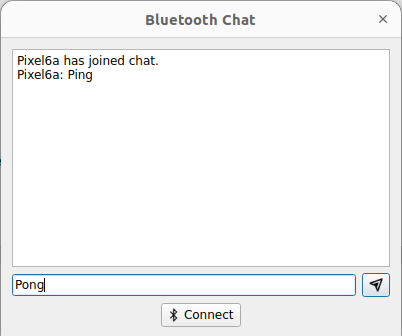蓝牙聊天
显示使用 RFCOMM 协议通过蓝牙进行的通信。
蓝牙聊天示例展示了如何使用 API Qt BluetoothAPI 与远程设备上的另一个应用程序使用蓝牙 RFCOMM 协议进行通信。

蓝牙聊天示例实现了多方之间的简单聊天程序。应用程序始终同时充当服务器和客户端,无需确定谁应该连接谁。
运行示例
要从 Qt Creator打开Welcome 模式,并从Examples 中选择示例。更多信息,请参阅Qt Creator: 教程:构建并运行。
聊天服务器
聊天服务器由ChatServer 类实现。ChatServer 类声明为
class ChatServer : public QObject { Q_OBJECT public: explicit ChatServer(QObject *parent = nullptr); ~ChatServer(); void startServer(const QBluetoothAddress &localAdapter = QBluetoothAddress()); void stopServer(); public slots: void sendMessage(const QString &message); signals: void messageReceived(const QString &sender, const QString &message); void clientConnected(const QString &name); void clientDisconnected(const QString &name); private slots: void clientConnected(); void clientDisconnected(); void readSocket(); private: QBluetoothServer *rfcommServer = nullptr; QBluetoothServiceInfo serviceInfo; QList<QBluetoothSocket *> clientSockets; QMap<QBluetoothSocket *, QString> clientNames; };
聊天服务器需要做的第一件事就是创建QBluetoothServer 的实例,以监听传入的蓝牙连接。每当创建一个新连接时,就会调用clientConnected() 槽。
rfcommServer= newQBluetoothServer(QBluetoothServiceInfo::RfcommProtocol,this);connect(rfcommServer, &QBluetoothServernewConnection, this, QOverload<>::of(&ChatServer::clientConnected));boolresult= rfcommServer->listen(localAdapter);if(!result) { qWarning() << "Cannot bind chat server to" << localAdapter.toString(); return; }
只有当其他人知道聊天服务器存在时,它才会有用。为了让其他设备发现它,需要在系统的 SDP(服务发现协议)数据库中发布一条描述服务的记录。QBluetoothServiceInfo 类封装了一条服务记录。
我们将发布一条服务记录,其中包含对服务的一些文字描述、唯一标识服务的 UUID、可发现性属性和连接参数。
服务的文本描述存储在ServiceName 、ServiceDescription 和ServiceProvider 属性中。
serviceInfo.setAttribute(QBluetoothServiceInfo::ServiceName, tr("Bt Chat Server")); serviceInfo.setAttribute(QBluetoothServiceInfo::ServiceDescription, tr("Example bluetooth chat server")); serviceInfo.setAttribute(QBluetoothServiceInfo::ServiceProvider, tr("qt-project.org"));
蓝牙使用 UUID 作为唯一标识符。聊天服务使用随机生成的 UUID。
static constexpr auto serviceUuid = "e8e10f95-1a70-4b27-9ccf-02010264e9c8"_L1; serviceInfo.setServiceUuid(QBluetoothUuid(serviceUuid));
蓝牙服务只有在PublicBrowseGroup 中才能被发现。
const auto groupUuid = QBluetoothUuid(QBluetoothUuid::ServiceClassUuid::PublicBrowseGroup); QBluetoothServiceInfo::Sequence publicBrowse; publicBrowse << QVariant::fromValue(groupUuid); serviceInfo.setAttribute(QBluetoothServiceInfo::BrowseGroupList, publicBrowse);
ProtocolDescriptorList 属性用于发布远程设备连接到我们的服务所需的连接参数。在此,我们指定使用Rfcomm 协议,并将端口号设置为rfcommServer 实例正在监听的端口。
QBluetoothServiceInfo::Sequence protocolDescriptorList; QBluetoothServiceInfo::Sequence protocol; protocol << QVariant::fromValue(QBluetoothUuid(QBluetoothUuid::ProtocolUuid::L2cap)); protocolDescriptorList.append(QVariant::fromValue(protocol)); protocol.clear(); protocol << QVariant::fromValue(QBluetoothUuid(QBluetoothUuid::ProtocolUuid::Rfcomm)) << QVariant::fromValue(quint8(rfcommServer->serverPort())); protocolDescriptorList.append(QVariant::fromValue(protocol)); serviceInfo.setAttribute(QBluetoothServiceInfo::ProtocolDescriptorList, protocolDescriptorList);
最后,我们向系统注册服务记录。
serviceInfo.registerService(localAdapter);如前所述,传入连接在clientConnected() 插槽中处理,其中待处理连接连接到readyRead() 和disconnected() 信号。这些信号会通知其他用户有新客户连接。
void ChatServer::clientConnected() { QBluetoothSocket *socket = rfcommServer->nextPendingConnection(); if (!socket) return; connect(socket, &QBluetoothSocket::readyRead, this, &ChatServer::readSocket); connect(socket, &QBluetoothSocket::disconnected, this, QOverload<>::of(&ChatServer::clientDisconnected)); clientSockets.append(socket); clientNames[socket] = socket->peerName(); emit clientConnected(socket->peerName()); }
每当准备从客户端套接字读取数据时,就会调用readSocket() 插槽。该槽从套接字读取单行数据,将其转换为 UTF-8 格式,然后发出messageReceived() 信号。
void ChatServer::readSocket() { QBluetoothSocket *socket = qobject_cast<QBluetoothSocket *>(sender()); if (!socket) return; while (socket->canReadLine()) { QByteArray line = socket->readLine().trimmed(); emit messageReceived(clientNames[socket], QString::fromUtf8(line.constData(), line.length())); } }
每当客户端断开与服务的连接时,就会调用clientDisconnected() 插槽。该插槽会发出一个信号,通知其他用户客户端已断开连接,并删除套接字。
void ChatServer::clientDisconnected() { QBluetoothSocket *socket = qobject_cast<QBluetoothSocket *>(sender()); if (!socket) return; emit clientDisconnected(clientNames[socket]); clientSockets.removeOne(socket); clientNames.remove(socket); socket->deleteLater(); }
sendMessage() 插槽用于向所有已连接的客户端发送消息。信息会被转换成 UTF-8,并在发送给所有客户端之前加上换行符。
void ChatServer::sendMessage(const QString &message) { QByteArray text = message.toUtf8() + '\n'; for (QBluetoothSocket *socket : std::as_const(clientSockets)) socket->write(text); }
聊天服务器停止后,服务记录会从系统 SDP 数据库中删除,所有连接的客户端套接字都会被删除,rfcommServer 实例也会被删除。
voidChatServer::stopServer() {// 取消注册服务 serviceInfo.unregisterService();// 关闭套接字 qDeleteAll(clientSockets); clientNames.clear();// 关闭服务器 deleterfcommServer; rfcommServer=nullptr; }
服务发现
在连接服务器之前,客户端需要扫描附近的设备,搜索正在宣传聊天服务的设备。这项工作由RemoteSelector 类完成。
要开始服务查找,RemoteSelector 会创建QBluetoothServiceDiscoveryAgent 的实例并连接到其信号。
m_discoveryAgent = new QBluetoothServiceDiscoveryAgent(localAdapter); connect(m_discoveryAgent, &QBluetoothServiceDiscoveryAgent::serviceDiscovered, this, &RemoteSelector::serviceDiscovered); connect(m_discoveryAgent, &QBluetoothServiceDiscoveryAgent::finished, this, &RemoteSelector::discoveryFinished); connect(m_discoveryAgent, &QBluetoothServiceDiscoveryAgent::canceled, this, &RemoteSelector::discoveryFinished);
设置 UUID 过滤器,以便服务发现只显示宣传所需服务的设备。随后,FullDiscovery 开始运行:
m_discoveryAgent->setUuidFilter(uuid); m_discoveryAgent->start(QBluetoothServiceDiscoveryAgent::FullDiscovery);
当发现匹配的服务时,就会发出serviceDiscovered() 信号,并将QBluetoothServiceInfo 的实例作为参数。该服务信息用于提取设备名称和服务名称,并将新条目添加到已发现的远程设备列表中:
QString remoteName; if (serviceInfo.device().name().isEmpty()) remoteName = address.toString(); else remoteName = serviceInfo.device().name(); QListWidgetItem *item = new QListWidgetItem(QString::fromLatin1("%1 %2").arg(remoteName, serviceInfo.serviceName())); m_discoveredServices.insert(item, serviceInfo); ui->remoteDevices->addItem(item);
随后,用户可以从列表中选择一个设备,并尝试与之连接。
聊天客户端
聊天客户端由ChatClient 类实现。ChatClient 类声明为
class ChatClient : public QObject { Q_OBJECT public: explicit ChatClient(QObject *parent = nullptr); ~ChatClient(); void startClient(const QBluetoothServiceInfo &remoteService); void stopClient(); public slots: void sendMessage(const QString &message); signals: void messageReceived(const QString &sender, const QString &message); void connected(const QString &name); void disconnected(); void socketErrorOccurred(const QString &errorString); private slots: void readSocket(); void connected(); void onSocketErrorOccurred(QBluetoothSocket::SocketError); private: QBluetoothSocket *socket = nullptr; };
客户端创建一个新的QBluetoothSocket ,并连接到remoteService 参数描述的远程服务。插槽连接到套接字的readyRead(),connected() 和disconnected() 信号。
voidChatClient::startClient(constQBluetoothServiceInfo&remoteService) {if(socket)return;// Connect to servicesocket= newQBluetoothSocket(QBluetoothServiceInfo::RfcommProtocol); qDebug() << "Create socket"; socket->connectToService(remoteService); qDebug() << "ConnectToService done"; connect(socket, &QBluetoothSocket::readyRead, this, &ChatClient::readSocket); connect(socket, &QBluetoothSocketconnect(socket, &::disconnected, this, QOverload<>::of(&ChatClient::connected)); connect(socket, &QBluetoothSocket连接(socket, &::connected,this,& ChatClient::disconnected); connect(socket, &QBluetoothSocket连接(socket, &::errorOccurred, this,&ChatClient::onSocketErrorOccurred);}
套接字连接成功后,我们会发出信号通知其他用户。
void ChatClient::connected() { emit connected(socket->peerName()); }
与聊天服务器类似,当套接字提供数据时,也会调用readSocket() 槽。我们会逐行读取数据并进行 UTF-8 转换。然后发出messageReceived() 信号。
void ChatClient::readSocket() { if (!socket) return; while (socket->canReadLine()) { QByteArray line = socket->readLine().trimmed(); emit messageReceived(socket->peerName(), QString::fromUtf8(line.constData(), line.length())); } }
sendMessage() 插槽用于向远程设备发送信息。信息将转换为 UTF-8,并加上换行符。
void ChatClient::sendMessage(const QString &message) { QByteArray text = message.toUtf8() + '\n'; socket->write(text); }
要断开与远程聊天服务的连接,QBluetoothSocket 实例将被删除。
void ChatClient::stopClient() { delete socket; socket = nullptr; }
聊天对话框
本例的主窗口是聊天对话框,由Chat 类实现。该类显示单个ChatServer 与零个或多个ChatClient之间的聊天会话。Chat 类声明为:
class Chat : public QDialog { Q_OBJECT public: explicit Chat(QWidget *parent = nullptr); ~Chat(); signals: void sendMessage(const QString &message); private slots: void connectClicked(); void sendClicked(); void showMessage(const QString &sender, const QString &message); void clientConnected(const QString &name); void clientDisconnected(const QString &name); void clientDisconnected(); void connected(const QString &name); void reactOnSocketError(const QString &error); void newAdapterSelected(); void initBluetooth(); void updateIcons(Qt::ColorScheme scheme); private: int adapterFromUserSelection() const; int currentAdapterIndex = 0; Ui::Chat *ui; ChatServer *server = nullptr; QList<ChatClient *> clients; QList<QBluetoothHostInfo> localAdapters; QString localName; };
首先,我们构建用户界面
ui->setupUi(this); connect(ui->connectButton, &QPushButton::clicked, this, &Chat::connectClicked); connect(ui->sendButton, &QPushButton::clicked, this, &Chat::sendClicked);
我们创建ChatServer 的实例,并响应其clientConnected() 、clientDiconnected() 和messageReceived() 信号。
server = new ChatServer(this); connect(server, QOverload<const QString &>::of(&ChatServer::clientConnected), this, &Chat::clientConnected); connect(server, QOverload<const QString &>::of(&ChatServer::clientDisconnected), this, QOverload<const QString &>::of(&Chat::clientDisconnected)); connect(server, &ChatServer::messageReceived, this, &Chat::showMessage); connect(this, &Chat::sendMessage, server, &ChatServer::sendMessage); server->startServer();
针对ChatServer 的clientConnected() 和clientDisconnected() 信号,我们会在聊天会话中显示典型的 "X 已加入聊天 "和 "Y 已离开 "消息。
void Chat::clientConnected(const QString &name) { ui->chat->insertPlainText(QString::fromLatin1("%1 has joined chat.\n").arg(name)); } void Chat::clientDisconnected(const QString &name) { ui->chat->insertPlainText(QString::fromLatin1("%1 has left.\n").arg(name)); }
来自连接到ChatServer 的客户端的传入消息由showMessage() 插槽处理。聊天会话中会显示标有远程设备名称的消息文本。
void Chat::showMessage(const QString &sender, const QString &message) { ui->chat->moveCursor(QTextCursor::End); ui->chat->insertPlainText(QString::fromLatin1("%1: %2\n").arg(sender, message)); ui->chat->ensureCursorVisible(); }
点击连接按钮后,应用程序会启动服务发现,并显示远程设备上已发现的聊天服务列表。用户可为服务选择ChatClient 。
voidChat::connectClicked() { ui->connectButton>setEnabled(false);// 扫描服务 constQBluetoothAddressadapter=localAdapters.isEmpty()?QBluetoothAddress() : localAdapters.at(currentAdapterIndex).address(); RemoteSelector remoteSelector(adapter);#ifdef Q_OS_ANDROID // QTBUG-61392Q_UNUSED(serviceUuid); remoteSelector.startDiscovery(QBluetoothUuid(reverseUuid));#elseremoteSelector.startDiscovery(QBluetoothUuid(serviceUuid));#endif if(remoteSelector.exec()==QDialog::Accepted) { QBluetoothServiceInfo服务=remoteSelector.service(); qDebug() << "Connecting to service" << service.serviceName() << "on"<<service.device().name();// 创建客户端ChatClient*client = newChatClient(this); connect(client, &ChatClient::messageReceived, this, &Chat::showMessage); connect(client, &ChatClient::disconnected, this, QOverload<>::of(&Chat::clientDisconnected)); connect(client, QOverload<constQString&>::of(&ChatClient::connected), this, &Chat::connected); connect(client, &ChatClient::socketErrorOccurred, this, &Chat::reactOnSocketError); connect(this, &Chat::sendMessage,client, &ChatClient::sendMessage); client->startClient(service); clients.append(client); } ui->connectButton>setEnabled(true); }
作为对connected() 信号的回应,ChatClient ,我们会在聊天会话中显示 "Jo Joined chat with X."(与 X 加入聊天)消息。
void Chat::connected(const QString &name) { ui->chat->insertPlainText(QString::fromLatin1("Joined chat with %1.\n").arg(name)); }
我们会通过ChatServer 和ChatClient 实例发出sendMessage() 信号,向所有远程设备发送消息。
void Chat::sendClicked() { ui->sendButton->setEnabled(false); ui->sendText->setEnabled(false); showMessage(localName, ui->sendText->text()); emit sendMessage(ui->sendText->text()); ui->sendText->clear(); ui->sendText->setEnabled(true); ui->sendButton->setEnabled(true); #if defined(Q_OS_ANDROID) || defined(Q_OS_IOS) // avoid keyboard automatically popping up again on mobile devices ui->sendButton->setFocus(); #else ui->sendText->setFocus(); #endif }
当远程设备强制断开连接时,我们需要清理ChatClient 实例。
void Chat::clientDisconnected() { ChatClient *client = qobject_cast<ChatClient *>(sender()); if (client) { clients.removeOne(client); client->deleteLater(); } }
© 2025 The Qt Company Ltd. Documentation contributions included herein are the copyrights of their respective owners. The documentation provided herein is licensed under the terms of the GNU Free Documentation License version 1.3 as published by the Free Software Foundation. Qt and respective logos are trademarks of The Qt Company Ltd. in Finland and/or other countries worldwide. All other trademarks are property of their respective owners.

